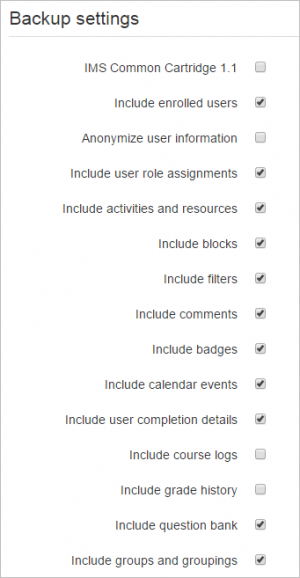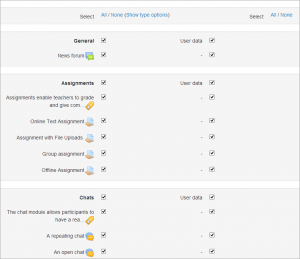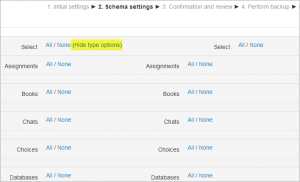Diferencia entre revisiones de «Respaldo del curso»
(tidy up) |
({{EnTraduccion}}) |
||
| Línea 1: | Línea 1: | ||
{{Versiones|Esta documentación es para Moodle 3.7 y más recientes. La documentación más antigua se encuentra en [[29/Respaldo del curso]] .}} | {{Versiones|Esta documentación es para Moodle 3.7 y más recientes. La documentación más antigua se encuentra en [[29/Respaldo del curso]] .}} | ||
{{Respaldo}} | {{Respaldo}}{{EnTraduccion}} | ||
'''Nota del traductor:''' La frase inglesa [https://docs.moodle.org/26/en/Backup backup] se tradujo como '''Copia de seguridad''' en el [[Español internacional]] y como [[Respaldo]] en el [[Español de México]]. | '''Nota del traductor:''' La frase inglesa [https://docs.moodle.org/26/en/Backup backup] se tradujo como '''Copia de seguridad''' en el [[Español internacional]] y como [[Respaldo]] en el [[Español de México]]. | ||
| Línea 14: | Línea 14: | ||
Para respaldar un curso | Para respaldar un curso | ||
# | # Vaya al curso. | ||
# | # elija el enlace para Respaldo, ya sea en el menú del engrane o en el Bloque de Administración (dependiendo del tema). | ||
# | # Configuraciones iniciales - Seleccione [[Actividades|actividades]], [[Bloques|bloques]], [[Filtros|filtros]] y otros ítems que requiera y después elija el botón 'Siguiente'. Los usuarios con los permisos apropiados, como los administradores y [[Mánager]], pueden elegir si es que quieren [[Respaldo de datos del usuario|incluir usuarios]], hacer anónima la información de usuarios, o incluir asignaciones de roles de usuarios, campos de usuarios, comentarios, detalles de finalización de usuario, [[Bitácoras|bitácoras]] del curso e historia de calificaciones en el respaldo. | ||
# Schema | # Configuraciones del ''Schema'' - Seleccionar/des-seleccionar ítems específicos para incluir en el respaldo, y luego elegir el botón 'Siguiente'. | ||
# If desired, select specific types of activity to be backed up by clicking the link 'Show type options' | # If desired, select specific types of activity to be backed up by clicking the link 'Show type options' | ||
# Confirmation and review - Check that everything is as required, using the Previous button if necessary, otherwise click the 'Perform backup' button | # Confirmation and review - Check that everything is as required, using the Previous button if necessary, otherwise click the 'Perform backup' button | ||
| Línea 23: | Línea 23: | ||
{| | {| | ||
[[File:backupgroups.png|thumb| | [[File:backupgroups.png|thumb|Configuraciones del respaldo]] | ||
| | | | ||
|[[File:26backuprestore1.png|thumb| | |[[File:26backuprestore1.png|thumb|Pantalla del respaldo con la opción para seleccionarlos todos o ninguno]] | ||
| | | | ||
|[[File:26backuprestore2.png|thumb| | |[[File:26backuprestore2.png|thumb|Pantalla del respaldo con la opción para seleccionar tipos de actividades]] | ||
|} | |} | ||
| Línea 34: | Línea 34: | ||
Tip: If you are satisfied with the default settings and don't wish to go through all the backup screens, you can simply click 'Jump to final step' to perform the backup. | Tip: If you are satisfied with the default settings and don't wish to go through all the backup screens, you can simply click 'Jump to final step' to perform the backup. | ||
==Hacer anónima la información de los usuarios== | |||
El anonimizar la información de los usuarios es una característica del respaldo que "proteje las identidades de los usuarios" al volver anónimos a los usuarios. Si se activa esta casilla en la configuración inicial del respaldo, Moodle substituirá alias en lugar de los nombres reales, por ejemplo remplazando las direcciones Email como @ejemplo.com y así sucesivamente. Por ejemplo, el usuario "Max Mánager" se volverá "anonfirstname4 anonlastname4". | |||
==Asynchronous course backups== | ==Asynchronous course backups== | ||
{{ | {{Nuevas características de Moodle 3.7}} | ||
Con cursos grandes es útil el poder continuar trabajando mientras el curso está siendo respaldado en segundo plano. Esto puede hacerse si el administrador activa la casilla para 'Habilitar resppaldos asincrónicos' desde ''Administración del sitio / Características avanzadas'' | |||
== | ==Respaldo vía CLI (Interfase por línea de comandos) para administradores== | ||
Site administrators can backup selected courses using a CLI script. | Site administrators can backup selected courses using a CLI script. | ||
=== | ===Opciones=== | ||
* --courseid=INTEGER (Course ID for backup.) | * --courseid=INTEGER (Course ID for backup.) | ||
* --courseshortname=STRING (Course shortname for backup.) | * --courseshortname=STRING (Course shortname for backup.) | ||
| Línea 53: | Línea 52: | ||
* -h, --help (Print out this help.) | * -h, --help (Print out this help.) | ||
=== | ===Ejemplo=== | ||
\$sudo -u www-data /usr/bin/php admin/cli/backup.php --courseid=2 --destination=/moodle/backup/ | \$sudo -u www-data /usr/bin/php admin/cli/backup.php --courseid=2 --destination=/moodle/backup/ | ||
== | ==Sugerencias y Trucos== | ||
* Lose content after a restore in Moodle 2.0 ? Do you see topic headings that say "Orphaned activities"? Solution: Go to course settings and increase the number of topic sections and things will return to normal. | * Lose content after a restore in Moodle 2.0 ? Do you see topic headings that say "Orphaned activities"? Solution: Go to course settings and increase the number of topic sections and things will return to normal. | ||
== | ==Usos creativos== | ||
The backup and restore processes can offer the teacher and administrators many creative solutions. | The backup and restore processes can offer the teacher and administrators many creative solutions. | ||
*Duplicating courses or specific activities in one course to another course (similar to Import) | *Duplicating courses or specific activities in one course to another course (similar to Import) | ||
| Línea 67: | Línea 66: | ||
*Creating a blank activity, save just that activity and then restore it to the course or another course one or more times. | *Creating a blank activity, save just that activity and then restore it to the course or another course one or more times. | ||
== | ==Predeterminados para respaldo general== | ||
Default settings for course backups can be set by a site administrator in 'General backup defaults' in the Site administration. | Default settings for course backups can be set by a site administrator in 'General backup defaults' in the Site administration. | ||
| Línea 80: | Línea 79: | ||
* not enough server RAM. Adding more RAM to your server is usually the first [[Performance_recommendations|performance recomendation]]. | * not enough server RAM. Adding more RAM to your server is usually the first [[Performance_recommendations|performance recomendation]]. | ||
== | ==Capacidades de respaldo de curso== | ||
*[[Capabilities/moodle/backup:anonymise|Anonymise user data on backup]] | *[[Capabilities/moodle/backup:anonymise|Anonymise user data on backup]] | ||
Revisión del 15:13 22 may 2019
| Existe documentación diferente para varias versiones de Moodle: Esta documentación es para Moodle 3.7 y más recientes. La documentación más antigua se encuentra en 29/Respaldo del curso . |
Nota del traductor: La frase inglesa backup se tradujo como Copia de seguridad en el Español internacional y como Respaldo en el Español de México.
Un curso puede guardarse con algunas o todas sus partes mediante el respaldo del curso. Típicamente, el administrador del sitio configurará una agenda para Respaldo de curso automatizado para todo el sitio. Un maestro con privilegios de edición puede crear un respaldo o descargar un respaldo existente, para salvaguardarlo, o para usarlo en otro sitio Moodle.
Respaldando un curso
Para respaldar un curso
- Vaya al curso.
- elija el enlace para Respaldo, ya sea en el menú del engrane o en el Bloque de Administración (dependiendo del tema).
- Configuraciones iniciales - Seleccione actividades, bloques, filtros y otros ítems que requiera y después elija el botón 'Siguiente'. Los usuarios con los permisos apropiados, como los administradores y Mánager, pueden elegir si es que quieren incluir usuarios, hacer anónima la información de usuarios, o incluir asignaciones de roles de usuarios, campos de usuarios, comentarios, detalles de finalización de usuario, bitácoras del curso e historia de calificaciones en el respaldo.
- Configuraciones del Schema - Seleccionar/des-seleccionar ítems específicos para incluir en el respaldo, y luego elegir el botón 'Siguiente'.
- If desired, select specific types of activity to be backed up by clicking the link 'Show type options'
- Confirmation and review - Check that everything is as required, using the Previous button if necessary, otherwise click the 'Perform backup' button
- Complete - Click the Continue button
Un archivo de respaldo (con una extensión distintiva .mbz para evitar confusión con archivos .ZIP) es entonces guardado en el área para respaldos del curso. Backup file names are of the form backup-moodle2-course-coursename-date-hour.mbz, ending in -nu.mbz when backed up with no users and -an.mbz with anonymized names.
Tip: If you are satisfied with the default settings and don't wish to go through all the backup screens, you can simply click 'Jump to final step' to perform the backup.
Hacer anónima la información de los usuarios
El anonimizar la información de los usuarios es una característica del respaldo que "proteje las identidades de los usuarios" al volver anónimos a los usuarios. Si se activa esta casilla en la configuración inicial del respaldo, Moodle substituirá alias en lugar de los nombres reales, por ejemplo remplazando las direcciones Email como @ejemplo.com y así sucesivamente. Por ejemplo, el usuario "Max Mánager" se volverá "anonfirstname4 anonlastname4".
Asynchronous course backups
¡Nueva característica
en Moodle 3.7!
Con cursos grandes es útil el poder continuar trabajando mientras el curso está siendo respaldado en segundo plano. Esto puede hacerse si el administrador activa la casilla para 'Habilitar resppaldos asincrónicos' desde Administración del sitio / Características avanzadas
Respaldo vía CLI (Interfase por línea de comandos) para administradores
Site administrators can backup selected courses using a CLI script.
Opciones
- --courseid=INTEGER (Course ID for backup.)
- --courseshortname=STRING (Course shortname for backup.)
- --destination=STRING (Path where to store backup file. If not set the backup will be stored within the course backup file area.)
- -h, --help (Print out this help.)
Ejemplo
\$sudo -u www-data /usr/bin/php admin/cli/backup.php --courseid=2 --destination=/moodle/backup/
Sugerencias y Trucos
- Lose content after a restore in Moodle 2.0 ? Do you see topic headings that say "Orphaned activities"? Solution: Go to course settings and increase the number of topic sections and things will return to normal.
Usos creativos
The backup and restore processes can offer the teacher and administrators many creative solutions.
- Duplicating courses or specific activities in one course to another course (similar to Import)
- Updating a production Moodle site course, with material from a localhost site course
- Transferring a course to a new Moodle site.
- In earlier versions of Moodle, a way of rolling a course forward without past student activity
- Creating a blank activity, save just that activity and then restore it to the course or another course one or more times.
Predeterminados para respaldo general
Default settings for course backups can be set by a site administrator in 'General backup defaults' in the Site administration.
Selected settings may be locked, so that they cannot be changed when creating a course backup.
By selecting a time in the "Keep logs for.." dropdown, it is possible to specify how long backup logs information is kept before being deleted. As this information may be very large, it is recommended the length of time chosen be quite short.
Course backup stops above 90%, not showing any errors
This has been reported to be caused by:
- a non-standard course_format. Try replacing the course format.
- not enough server RAM. Adding more RAM to your server is usually the first performance recomendation.
Capacidades de respaldo de curso
- Anonymise user data on backup
- Backup courses
- Backup sections
- Backup for hub
- Backup for import
- Configure backup options
- Download files from backup areas
- Backup user data
Vea también
- Restauración de curso
- Respaldo de datos del usuario
- Respaldo de actividad
- Moodle 2 Administration Courses MoodleBites video on YouTube
- Los administradores también pueden usar MOOSH para respaldar y restaurar cursos masivamente desde la Interfaz por Línea de Comando


